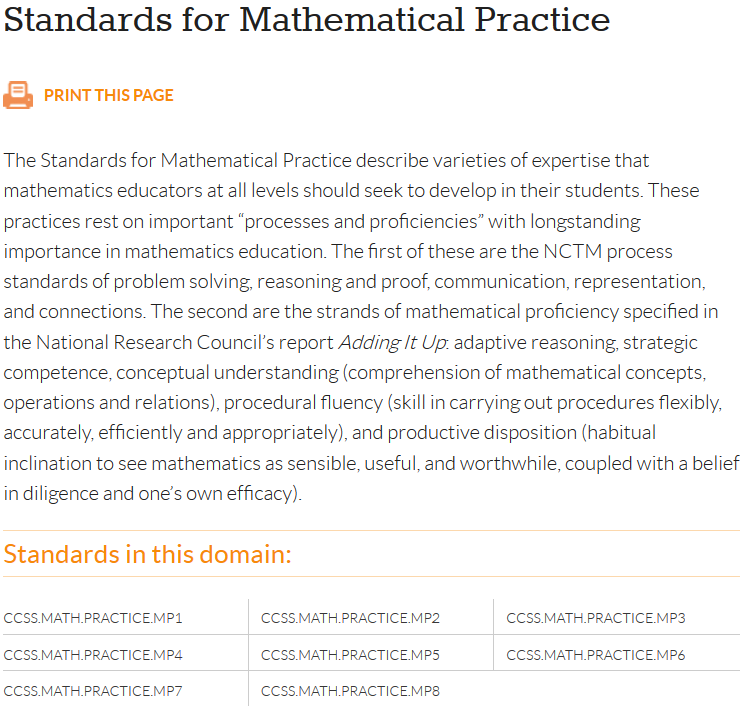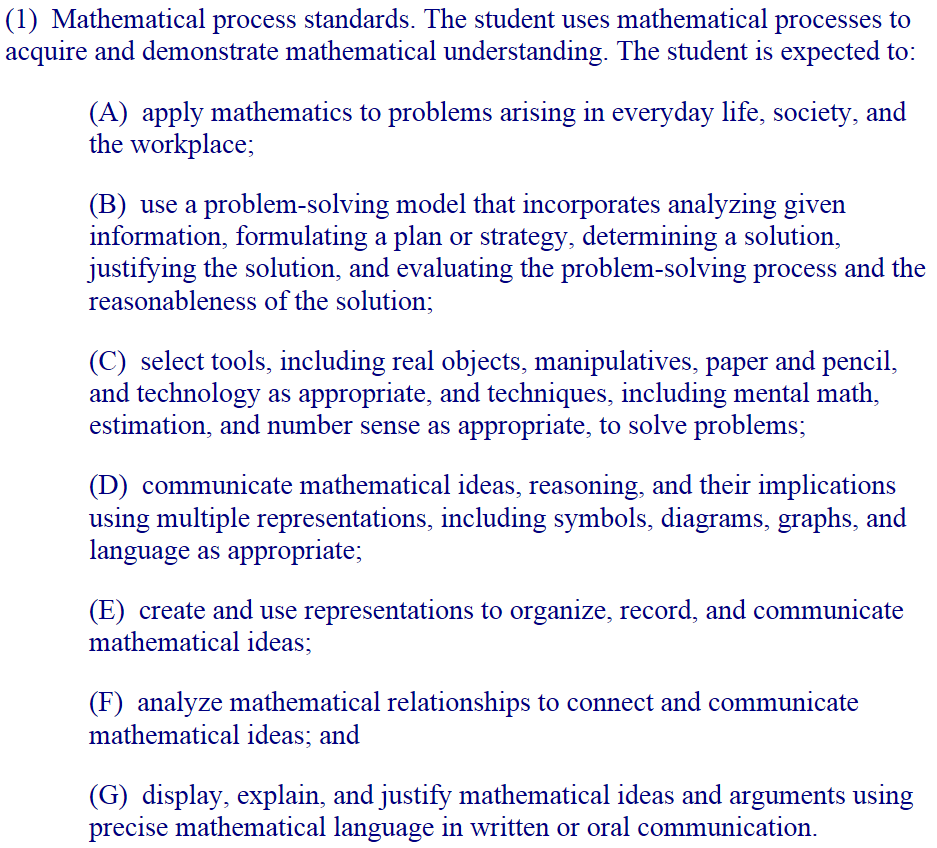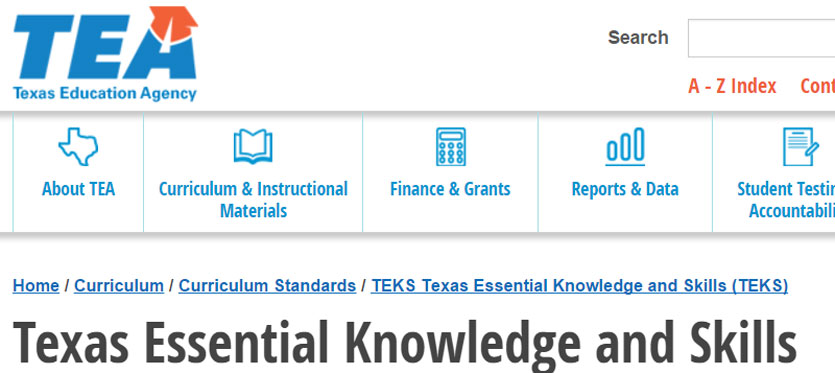How do the Common Core State Standards‘ (CCSS) description for how students are expected to demonstrate their mathematical understanding compare to the Texas Essential Knowledge and Skills‘ (TEKS) description? I wondered about that question as this summer I will be doing my first workshops and presentations in Texas. As I primarily work in California where the CCSS have been adopted, I am much more familiar with those and knew very little about the TEKS. The following is the result of what I hope is an objective comparison between the two sets of standards.
The CCSS describe expectations for how students should demonstrate their mathematical understandings through the Standards for Mathematical Practice. These 8 standards are the same for every grade level from K through 12.
The TEKS describe expectations for how students should demonstrate their mathematical understandings through the Mathematical Process Standards. These 7 standards are the same for every grade level from K through 12.
Here is my attempt at matching each Mathematical Process Standard to one or more Standards for Mathematical Practice.
“apply mathematics to problems arising in everyday life, society, and the workplace”
“apply the mathematics they know to solve problems arising in everyday life, society, and the workplace.” (
Math Practice 4)
“use a problem-solving model that incorporates analyzing given information, formulating a plan or strategy, determining a solution, justifying the solution, and evaluating the problem-solving process and the reasonableness of the solution”
“start by explaining to themselves the meaning of a problem and looking for entry points to its solution… plan a solution pathway rather than simply jumping into a solution attempt. They monitor and evaluate their progress and change course if necessary… [and] check their answers to problems using a different method, and they continually ask themselves, ‘Does this make sense?'” (
Math Practice 1)
“select tools, including real objects, manipulatives, paper and pencil, and technology as appropriate, and techniques, including mental math, estimation, and number sense as appropriate, to solve problems”
“consider the available tools when solving a mathematical problem. These tools might include pencil and paper, concrete models, a ruler, a protractor, a calculator, a spreadsheet, a computer algebra system, a statistical package, or dynamic geometry software… They detect possible errors by strategically using estimation and other mathematical knowledge… They are able to use technological tools to explore and deepen their understanding of concepts. (
Math Practice 5)
“communicate mathematical ideas using language, efficient tools, appropriate units, and graphical, numerical, physical, or algebraic mathematical models” “communicate mathematical ideas, reasoning, and their implications using multiple representations, including symbols, diagrams, graphs, and language as appropriate”
“communicate precisely to others. They try to use clear definitions in discussion with others and in their own reasoning… They are careful about specifying units of measure.” (
Math Practice 6) and “can explain correspondences between equations, verbal descriptions, tables, and graphs” (
Math Practice 1)
“analyze mathematical relationships to connect and communicate mathematical ideas”
“justify their conclusions, communicate them to others, and respond to the arguments of others… Mathematically proficient students are also able to compare the effectiveness of two plausible arguments, distinguish correct logic or reasoning from that which is flawed, and—if there is a flaw in an argument—explain what it is.” (
Math Practice 3)
“evaluate the effectiveness of different representations to communicate ideas”
“make conjectures from patterns or sets of examples and nonexamples” “create and use representations to organize, record, and communicate mathematical ideas”[/one_half][one_half last=”yes”]”look closely to discern a pattern or structure” (
Math Practice 7) and “notice if calculations are repeated, and look both for general methods and for shortcuts” (
Math Practice 8)
“display, explain, and justify mathematical ideas and arguments using precise mathematical language in written or oral communication.”
“understand and use stated assumptions, definitions, and previously established results in constructing arguments” (
Math Practice 3) and “communicate precisely to others. They try to use clear definitions in discussion with others and in their own reasoning… They are careful about specifying units of measure.” (
Math Practice 6)
I was surprised to see such a strong correlation between the two sets of standards. The CCSS and TEKS have much in common as to how students should demonstrate their mathematical understanding. Realizing this and rallying around these shared student expectations will help us all as we do better working together in collaboration than we do working separately in isolation.
This
crosswalk comparing TEKS and Common Core content standards from
Nicole Ayers may be helpful for you as well.




Excellent post! Sadly, the CCSS have become so politicized here that we’re not even allowed to speak of them (see https://www.nbcnews.com/news/education/meet-americas-most-hardcore-anti-common-core-moms-n150146 for an example of those who think I should be in jail for supporting (even if just parts of) the CCSS. I’m guessing that the teachers you’ll be working with will have zero experience with the CCSS.
When/where are you going to be in Texas?! I’d love to see one of your workshops in action (or at least get an idea of where you’ll be and see if I can give you some insider info).
Keep up the great work and I’d love to get you to Austin sometime!
Adam @AGHolman
Interesting article. My favorite part was “A recent Gallup poll showed that 61 percent of parents know little or nothing about the Common Core. But the 19 percent who view the standards ‘very negatively,’ particularly in red states, are the parents driving the debate and making Common Core a wedge issue in the upcoming election.”
I’ll be just as happy if teachers have experience with those three “underlying processes and mathematical tools” standards.
I will be at CAMT in Ft. Worth next week and at The Kinkaid school in Houston in August. Hopefully our paths will cross soon.
I noticed that you did your comparison to the old TEKS. We are now transitioning to our newly adopted standards which have the process standards placed at the beginning of the knowledge and skills for each grade level. If you scroll down on this link: http://ritter.tea.state.tx.us/rules/tac/chapter111/ch111b.html, look for the TEKS that were adopted in 2012. Our process standards are now the first strand called the mathematical process standards. These are the same for K-8. Hope this is helpful! Have a great time at CAMT!
Thank you so much Beth. This is exactly what I mean by “we do better working together in collaboration than we do working separately in isolation.” I appreciate this heads up and I have modified the post accordingly to align it to the 2012 TEKS standards as well.
Beth and Robert,
The 2012 update made the process standards the same for K through secondary mathematics, including Statistics and Algebraic Reasoning!
Thank you for this! I constantly find fantastic resources only to have the extra step of cross-referencing CCSS with TEKS . Then, of course, just as I get in a groove, more changes to the TEKS. Every extra step eliminated or made simpler in the planning process increases available time to spend with my family.
This is a great side by side reference for that portion of our TEKS! Thanks again.
Carrie
8th Grade Math
Tyler, Texas
This is great. Would you happen to know if there are content standard comparisons for grades 6-8?
Unfortunately I don’t know of any content standard comparisons. If you find something, please post a link as a comment. Thanks.
Carlo, I saw this a while back and you got me thinking. Started work tonight on a rudimentary spreadsheet –
https://docs.google.com/spreadsheets/d/1rduSFXOq8ChTs4LoYQ5hOL9VbQhLVlEuPK3tdyu8OA8/edit?usp=sharing
To start I’ve done some conditional formatting for key words such as ratio, rate, proportionality to be able to group the sets of standards – the thought is similar to Robert’s analysis here, knowing that many of the same traits are probably shared throughout just in different ways. The conditional formatting will help get a rough sort and then I can more easily fine-tune from there. I didn’t finish as it’s getting late, but feel free to edit that document.
Obviously it won’t be a true comparison because just as CCSS moved around the order of many other standards that used to be in certain places, some content is in different grades etc. Cheers!
Thank you for sharing this!
Brandon –
I have been searching for a high level comparison of the CCSS to the TEKS at grades 6-8. Thank you for sharing this. May I ask you about your color coding? What do the colors represent?
I am a bit late getting into this conversation but this popped up when I was looking for a connection of the TEKS and CCSS. I attempted to look at the sheets link but it is no longer available. Would anyone be able to help with this dilemma?
I know that the blue, green and yellow represent major, supporting and additional clusters with respect to the PARCC Assessments. But that does not seem to relate to your alignment.
Brandon,
Your spreadsheet that you shared is awesome! Have you done any updates to it since September?
Thanks for sharing such an awesome resource.
Hey, Robert! Great resource….In my district’s advanced math course for teachers called “Math Rocks”, we often get asked “What is the difference between common core and the TEKS?”
The answer has always sounded like yours: They are pretty similar.
Since we are trying to introduce teachers to your work, and others in the MTBoS, we point out the advantage of seeing the similarities: to have a common language with teachers throughout the country. There are so many great things coming out from math leaders, like you, that it helps to understand each other.
Thanks again!
Thanks Leilani. I mean really, how different could it possibly be? Are some states not teaching how to solve equations or add fractions? It’s all politics, and having a common language is certainly helpful.
To be clear, I’ve got major concerns with the Common Core State Standards (https://robertkaplinsky.com/open-letter-writers-future-math-standards/), but I think it was a step in the right direction.
Is there a Common Core Standard to TEKS side by side/equivalent chart for ELAR ?
Sorry Tana. I’m not very familiar with the ELA standards.
I am looking for the same thing Tana.
Thanks! This is great. Especially helpful in translating sites like Yummy Math, which posts CC standards. I know I will use this often!
Hello,
Have you done a comparison for grades K – 2?
Hi Phyllis. I believe that the CCSS Practice Standards and the TEKS Process Standards are the same for K-12. So, unless I am missing something, this should be the same.
I am a bit late getting into this conversation but this popped up when I was looking for a connection of the TEKS and CCSS. I attempted to look at the sheets link but it is no longer available. Would anyone be able to help with this dilemma?
Sorry, it wasn’t my sheet. I don’t know what else can be done.
I think you can find it on Teachers Pay Teachers. It’s about $1 per grade level. I’ve had to use it as a private school teacher in Texas who uses common core, but has to compare to public school.